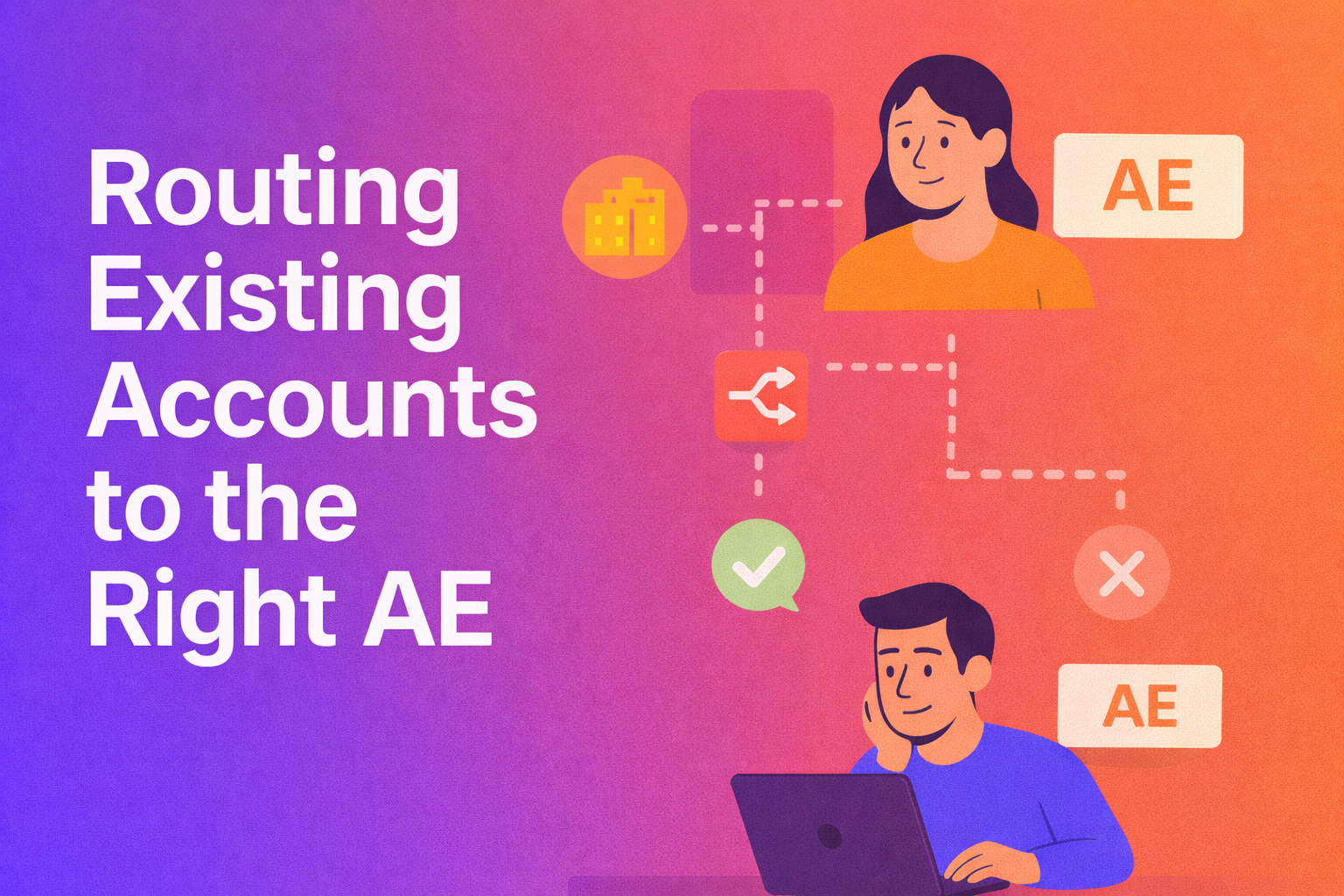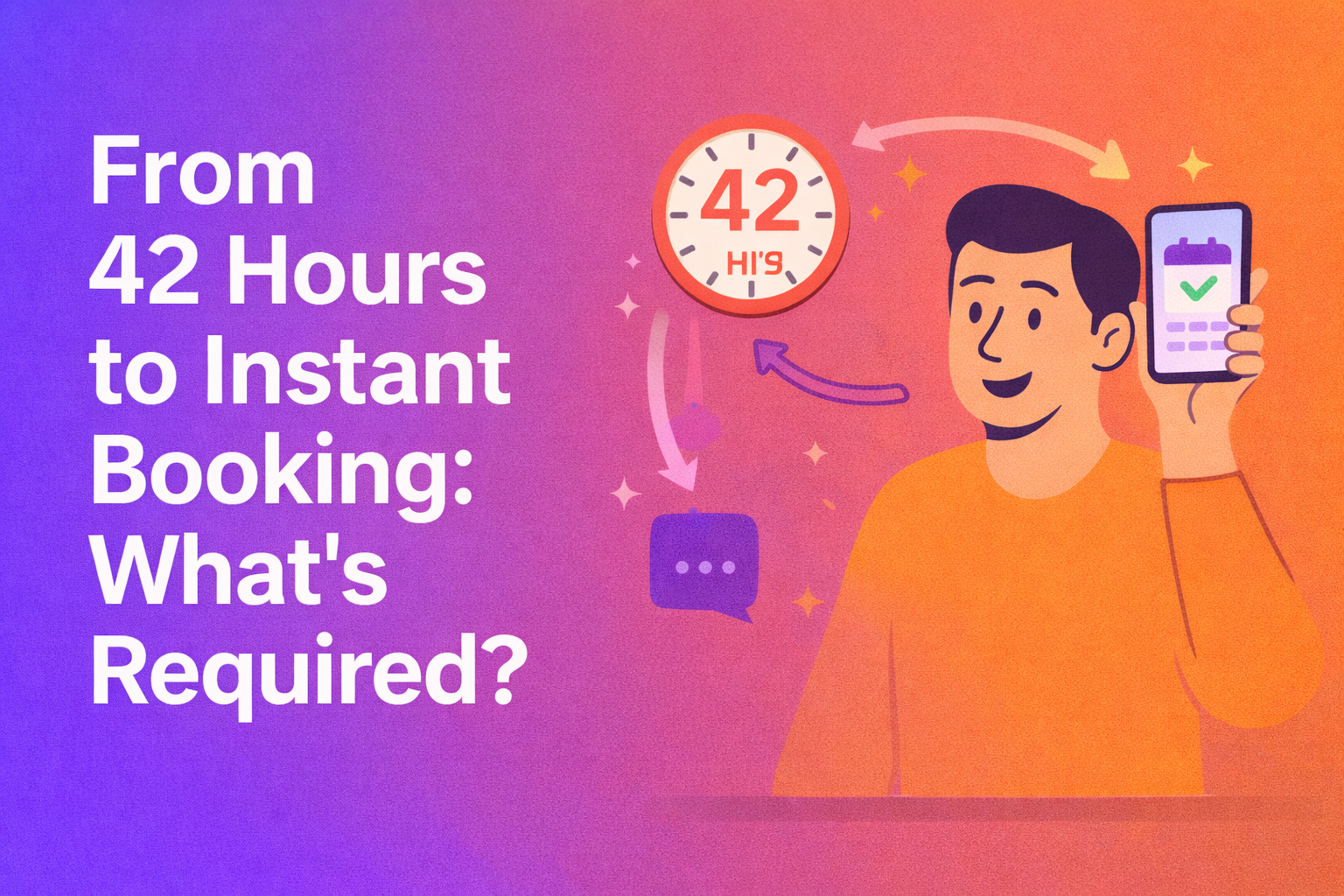If your B2B company is driven by a demo request or “talk to sales” play, you need to be fully equipped with the essential tools that will help your reps schedule meetings in a jiffy.
And knowing how to schedule a Google Meet for demos is important because it is one of most used video conferencing tools that helps you get everything done within your Google ecosystem.
But as a sales function, you should also think about how to schedule a Google Meet while keeping the buyer experience consistent and frictionless.
This article will cover everything you need to know about how to schedule a meeting in Google Meet and how you can use it to power your inbound and outbound sales engines.
Here’s a quick rundown of what we will cover:
- How you can get up to speed with how to schedule a Google Meet with step-by-step guidance.
- Pro tips to get more out of your Google Meet beyond basic scheduling instructions and handling meetings.
- The limitations of Google Meet as a standalone tool for sales professionals who want to keep their demo request funnel converting like clockwork.
- How you can use Google Meet to fix your sales process and workflows, and accelerate your response to demo requests.
How to schedule a Google Meet
Step 1: Accessing Google Meet
First things first, you'll need to have a Google account. If you don't have one already, it's easy and free to create. This support article from Google has pointers to create a Google account for both an individual and a business. Once you're done creating, you can access Google Meet through the web browser, the mobile app, or through Google Calendar.
Step 2: Scheduling a meeting on Google Meet
If you’re using Google Meet, chances are that you’re already in the Google ecosystem. Or your company must be using the Google business suite for virtual workplace needs.
If you're using Google Calendar to schedule your meetings (which is highly recommended for its seamless integration), follow these steps:
- Open Google Calendar.
- Click on the "+ Create" button to create a new event.
- Enter the event details such as title, date, and time.
- In the "Add guests" field, input the email addresses of the participants you want to invite.
- Click on the "Add Google Meet video conferencing" option to automatically generate a Google Meet link for the meeting.
- Click "Save" to schedule the meeting.
Look into options like blocking busy hours and setting repeat meetings to be more systematic with your meetings.
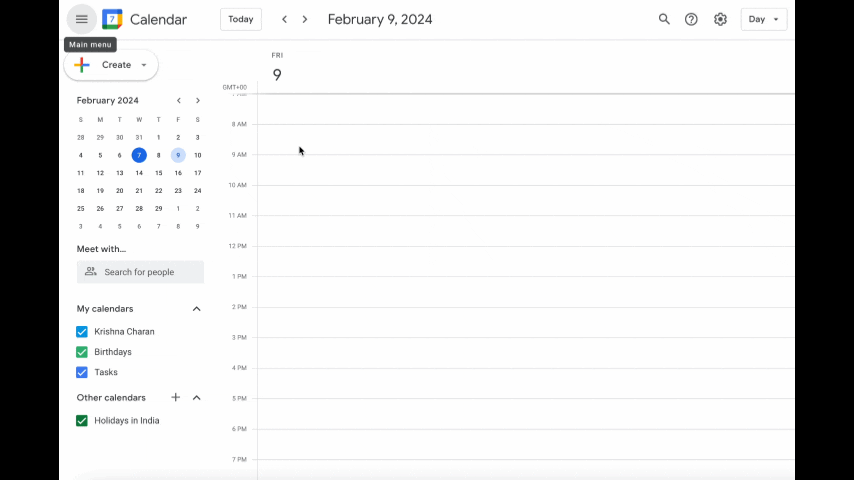
If you’re using Google Meet on the web app, you get three options:
- Create a meeting link for later – You can use this to generate a link for later and then send it to others to hop on the call.
- Start an instant meeting – Start a meeting immediately and share the meeting link for others to join the call.
- Schedule in Google Calendar – This takes you to the Google Calendar pop-up, where you can add attendees, set up time, and get more advanced options.

Step 3: Customizing your meeting settings
Google Meet offers several customization options to tailor your meeting according to your needs. You can control settings such as who can join the meeting directly, whether participants need to wait in the lobby before being admitted, and whether participants can present or mute themselves.
You can find these settings under “Event Details”, when you click ⚙️ icon.
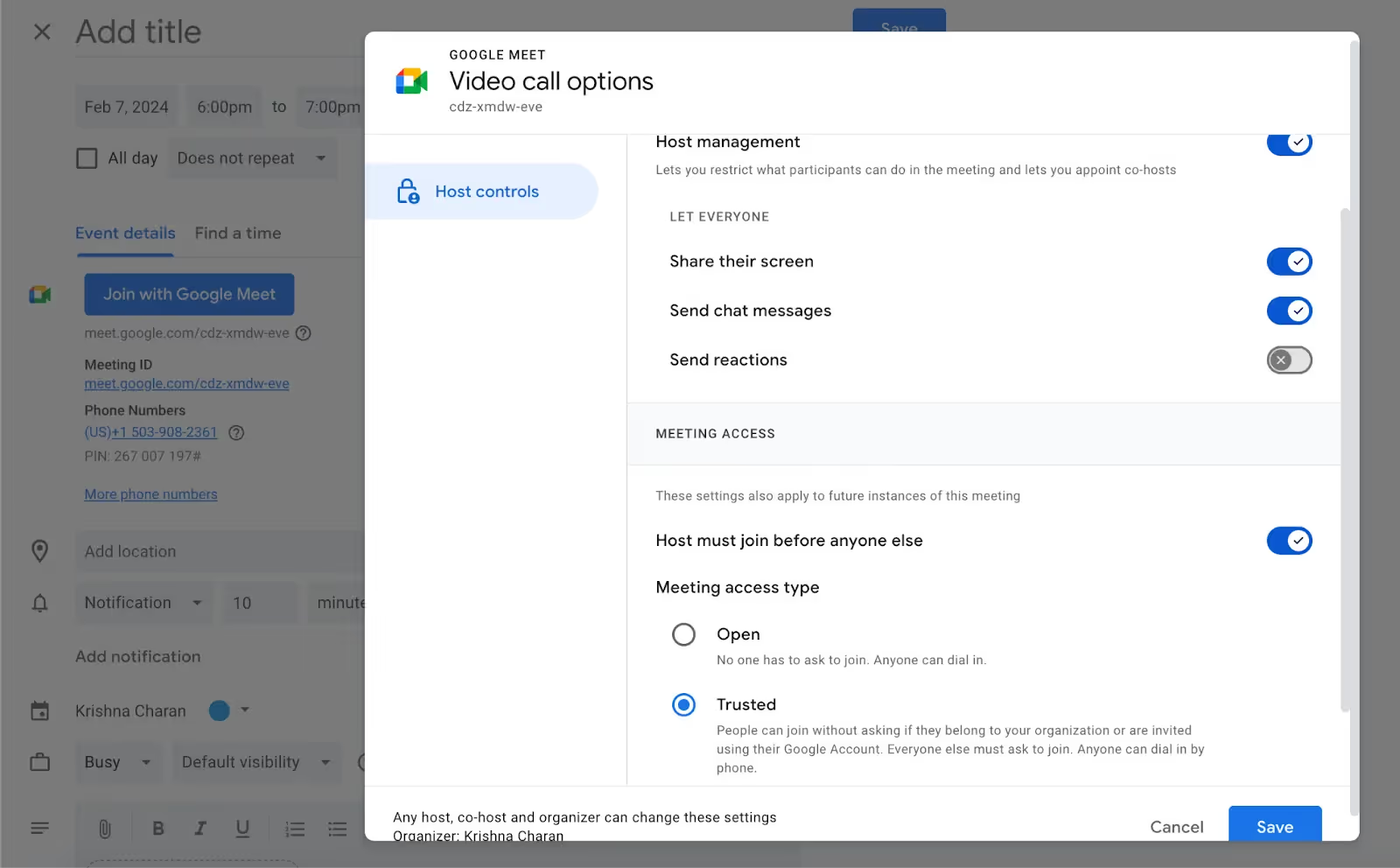
Step 4: Sending meeting invitations
Once your meeting is scheduled, Google Calendar will automatically send email invitations to the participants you've added. These invitations will include all the necessary details such as the meeting link, date, time, and any additional notes or collaterals you may have added.
Participants can simply click on the link to join the meeting at the scheduled time. The Google Calendar will also send reminders by default before the meeting starts. You can customize these alerts for any time before the meeting.
Best practices to follow after you schedule a Google Meet
Maximizing the features available in Google Meet can significantly enhance the overall meeting experience, whether it’s an internal or customer call.
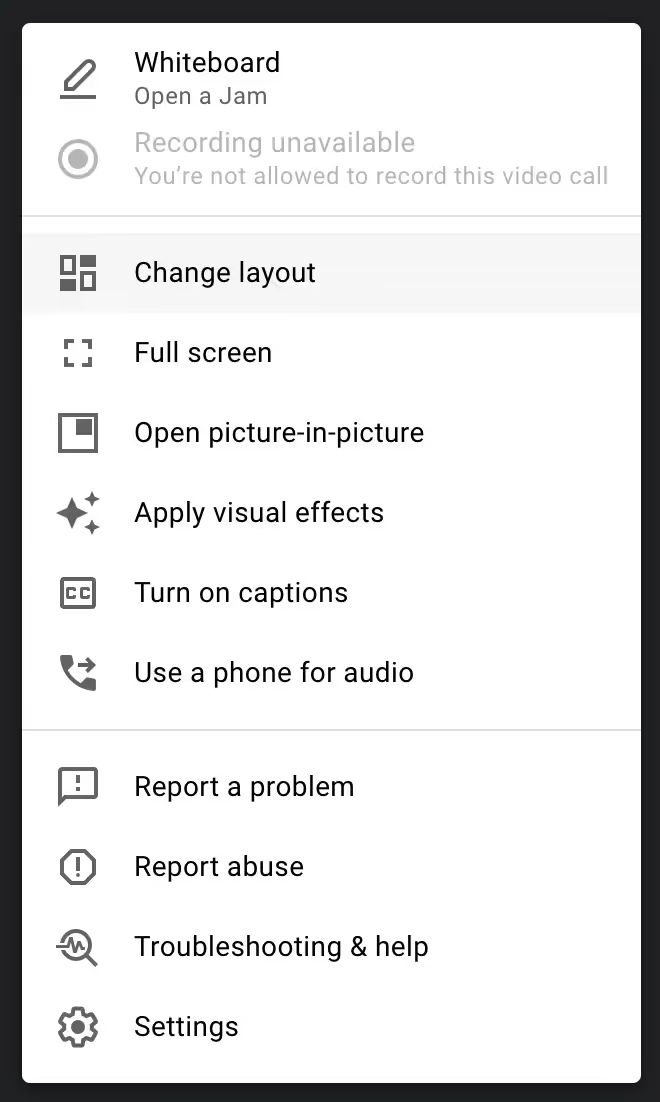
Here are some tips to get the most out of features after you start your scheduled Google Meet:
- Use meeting reminders to reduce no shows: Whether the meeting is internal in the org or sales meeting with a prospect, virtual meetings attract a lot of no shows. With Google Meet you can be proactive and set up multiple meeting reminders at customized intervals before the meeting starts.
- Turn on HD video and audio: Ensure that you have enabled HD video and high-quality audio for a clear and crisp meeting experience. You can adjust these settings in the Google Meet settings menu.
- Leverage “present” mode: When sharing your screen or presenting slides, use the Present mode feature to ensure that your content is displayed optimally. This eliminates distractions and focuses participants' attention on the shared material.
- Play around Grid and Spotlight views to customize your view: Grid view allows you to see multiple participants at once, fostering a more engaging and interactive meeting environment. Spotlight view enables you to highlight a specific participant's video feed, making it ideal for presentations or when a single participant is speaking.
- Enable background blur or virtual Backgrounds: If you're joining the meeting from a busy or distracting environment, consider using background blur or virtual backgrounds to minimize distractions and maintain professionalism. This feature can help keep the focus on you during the meeting.
- Use hand raise feature: Encourage participants to use the hand raise feature when they have a question or comment. This allows for a more orderly discussion and ensures that everyone has an opportunity to contribute without interrupting the flow of the meeting.
- Get feedback through chat and reactions: Engage participants with the chat feature to ask questions, share links, or provide feedback during the meeting. Additionally, utilize reactions such as thumbs up, clapping, or raising hands to gauge participant engagement and sentiment.
- Collaborate with Google Docs, Sheets, and Slides: Take advantage of real-time collaboration features by integrating Google Docs, Sheets, and Slides directly into your meeting. This allows participants to edit and collaborate on documents together, fostering teamwork and productivity.
This will also come in handy when you’re taking prospects and customers through your product’s value props, pitch decks, and use cases.
- Record meetings for future reference (with permission): Consider recording the meeting for participants who are unable to attend or for future reference. Google Meet offers a built-in recording feature that allows you to easily capture and share the meeting with others.
- Utilize breakout rooms: If you have a large group of participants, consider using breakout rooms to facilitate smaller group discussions or activities. For instance, this will help GTM teams like sales share their ideas and progress to their skip-level in a larger meeting to reconvene on the main meeting later.
- Monitor meeting controls: As the meeting host, familiarize yourself with the various meeting controls available to you, such as muting participants, controlling screen sharing, and managing participant access.
How to schedule a Google Meet to drive more pipeline?
Now, how do your sales reps normally use Google Meet in the sales context? Here’s how the flow roughly goes on inbound scenarios today:
- Your prospects fill up a demo or meeting request form on your website to evaluate your product.
- Your sales reps run lead qualification benchmarks (such as company size, role, revenue, etc.,) on these inbound contacts and identify the most high-intent ones.
- Based on the attributes of the contacts, each lead is manually assigned to the SDR or AE who might be the best person available to take the conversation forward.
- You then reach out to your qualified prospects via email to ask what would be a good time to set up a meeting.
- Now, your SDRs either send a Google Meet video conferencing invite for the agreed time. Or you have an integrated external calendar with Google Meet, so that prospects can book their favorite slot.
- Many prospects, however, don’t show up to the booked meeting because you’re not sending timely alerts and reminders before the meeting. The bigger challenge is to nurture them back to book another meeting with you.
Imagine the hours and days your reps spend in back and forth emails and sales spreadsheets instead of reaching out to the prospect when their buyer intent is high. The workflow is not too different for outbound either, except that your SDRs might repeat points 3 and 4 from above.
Here’s where an instant meeting scheduling tool like RevenueHero can make Google Meet meaningfully contribute to your qualified pipeline by removing your sales reps’ grunt work.
RevenueHero simplifies scheduling a Google Meet for prospects and sales reps at once
Using Google Meet as a standalone will not really save your sales team from the manual pitfalls of scheduling meetings with prospects.
But RevenueHero’s instant qualification, routing, and scheduling can help you optimize meetings on Google Meet for a frictionless buyer journey right across your GTM funnel.
1. Enable prospects to schedule a Google Meet right after demo form-fills on your website
The demo request flow, as it is today, is broken. If your website shows a thank you page with the message “someone will reach out to you within 48 hours” after a form-fill, your demo request flow is broken.
It’s fair to assume that when prospects see a “book a demo” CTA on your website, they want to book a demo NOW—not some time later—as they shop around with other players in your market.
With RevenueHero, you can instantly display your best rep’s calendar once prospects submit their info on your website forms. This can save numerous days from your sales cycle by eliminating the back-and-forth involved in agreeing over a meeting time on Google Meet.
Pro tip: Add lead qualification and routing conditions to your Google Meet scheduling flow.
Tools like RevenueHero let you qualify and route meetings based on custom logic such as:
- Prospect attributes: Company size, region, time zone, industry, designation, etc.,
- SDR attributes: Team, time zone, expertise, account ownership (lead-to-account matching), etc.,
- Distribution logic: Strict, flexible, and weighted round robin.
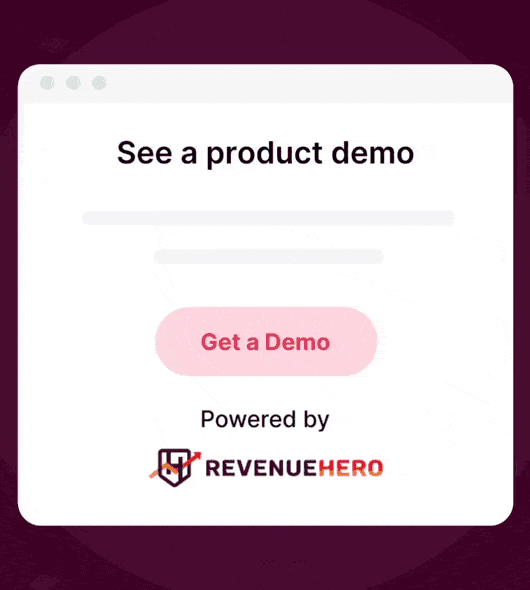
2. Distribute outbound emails and follow-ups to the right sales reps in 1 click
Marketers drive the messaging for personalized email campaigns such as reactivation nurtures and ABM.
Considering the volume of emails could be huge, think about the hassle involved in identifying the right campaign owners among sales reps to assign meetings. It would also be futile to expect prospects to do the hard work of agreeing to meetings verbally and filling up a demo form.
With RevenueHero’s 1-click magic links, marketers can include CTAs in emails that automatically identify your prospects from the CRM and enable the prospect to book a meeting instantly with the best sales rep available. All without asking the prospect to fill up a form again.
Marketers love tracking every bit of interaction. Which is why RevenueHero lets you track these email campaigns and nurtures at a granular level:
- Did that demo come from a nurture email?
- What campaign resulted in more demo bookings and pipeline?
- Which region requires better messaging based on campaign clicks?
- Which campaigns had more meeting no shows and how sales reps owning them performed?
Magic links can save hours of insignificant grunt work every week, and help GTM teams focus on generating demand, triggering buyer intent, prospecting, and building rapport with buyers instead.

3. Handoff prospects to AEs or book meetings on behalf of the right AE’s
Finding the right AE from a cluster of sheets is a tiresome job by itself. In addition to it, going on to play cupid between AE and prospect availability can suck invaluable prospecting time out of SDRs.
Relays by RevenueHero addresses this age-old problem by automating meeting handoffs to the right AE in just 2 clicks. And like magic links, Relays links with Google Meet can be added to outreach emails with which prospects can schedule a meeting with the best available AE instantly.
Apart from an SDR-to-AE Google Meet handoff, the use cases can also be extrapolated for AE-to-implementation or support-to-CSM handoffs.
4. Let your product qualified leads (PQLs) book a meeting with your sales rep from within your product
It’s tricky to reach a consensus about adding sales-assistance to your PLG motion. With a freemium product, you have too many users who might want to talk to your sales.
But here’s an experiment that can transform your sales-assisted PLG. With RevenueHero, you can set up in-app meetings based on user intent and product usage for specific prospects who are likely to convert.
This way, your PQLs can instantly schedule a Google Meet from a sticky feature or a locked functionality that requires moving to a higher pricing tier.
Here’s an example of Mailmodo’s in-app scheduler deployed using RevenueHero:

Generate qualified pipeline with Google Meet and RevenueHero
If you’re looking to get more out of Google Meet and turn it into a sales sidekick for your reps, RevenueHero is just what you need. Give your qualified prospects a frictionless meeting booking experience, and by extension a buyer experience they’ll not forget.
Interested in finding out how RevenueHero can power your qualified meetings? Book a personalized demo with us now.
Let RevenueHero help your team turn high-intent users into booked meeting without slowing down your funnel.



.png)
